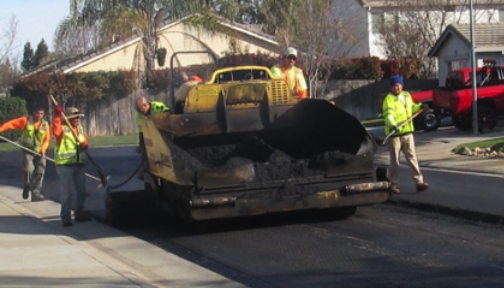Reimagine Your Area: Hot Mix Asphalt Paving for Angled Parking Lot Tasks
Unlocking the Tricks of Hot Mix Asphalt Modern Technology
Discovering the depths of warm mix asphalt technology uncovers a world where accurate solutions and meticulous processes merge to shape our roadways and infrastructure. The combination of binders, accumulations, and fillers isn't merely a building task however a calculated orchestration of durability and effectiveness. As we peer into the elaborate dancing of elements, a tapestry of durability and sustainability unravels. What lies underneath this surface area of asphaltic mastery, and what tricks wait to be introduced in the world of leading advancements?
Importance of Hot Mix Asphalt
Warm Mix Asphalt plays a critical duty in modern-day infrastructure growth due to its sturdiness and cost-effectiveness. As the most frequently utilized paving material for roads, highways, and parking area, Hot Mix Asphalt uses a variety of advantages that add to its value in construction projects. One vital benefit is its capacity to endure hefty web traffic loads and rough weather, supplying a reputable and resilient surface area for transportation networks. Additionally, Hot Mix Asphalt is affordable in both initial building and long-lasting maintenance, making it a favored option for lots of facilities tasks.
The sturdiness of Hot Mix Asphalt stems from its structure, which includes accumulations, binder, and filler materials that are very carefully chosen and blended to satisfy certain performance demands. Overall, the value of Hot Mix Asphalt in facilities development can not be downplayed, as it proceeds to be a keystone of modern building techniques.
Elements of Asphalt Mixes
The composition of asphalt blends contains carefully chosen aggregates, binder, and filler materials that are crucial for attaining particular performance requirements. Aggregates are the primary part of asphalt mixes, giving toughness and security. These accumulations can be natural, such as gravel or smashed rock, or artificial, like recycled materials from old sidewalks. The binder, generally bitumen or asphalt cement, holds the aggregates together and gives adaptability and sturdiness to the mix. The selection of the binder is vital as it directly affects the mix's performance in various weather condition problems. Fillers, such as hydrated lime or Rose city concrete, are made use of to boost the mix's workability and aging resistance. Angled Parking.
The mix and percentage of these components play a considerable function in figuring out the top quality and efficiency of the asphalt mix. Designers carefully create the mix to meet certain demands, thinking about variables like website traffic volume, climate conditions, and sidewalk life expectancy. Correct choice and balancing of aggregates, binder, and fillers are vital for creating resilient, durable asphalt pavements.
Mixing and Manufacturing Strategies

As soon as the accumulations are picked, the binder, usually asphalt concrete, is included in bind the products with each other. The binder's high quality and amount considerably influence the mix's toughness, versatility, and resistance to ecological variables. Additionally, fillers like moisturized lime or Portland cement may be integrated to enhance certain attributes of the asphalt mix, such as its workability or moisture resistance.
During production, the aggregates and binder are warmed, usually between 250-325 ° F(121-163 ° C ), to help with mixing and make sure correct coating of the aggregates. The blending procedure has to be comprehensive to achieve a homogeneous mixture that promotes the wanted efficiency features of the asphalt. Various methods, such as set blending or drum mixing, are employed to accomplish regular and premium asphalt blends for building jobs.
Aspects Affecting Asphalt Performance
Aspects affecting asphalt efficiency encompass an array of variables that affect the longevity, longevity, and overall top quality of asphalt sidewalks. One key aspect is the top quality of products utilized in the asphalt mix.

Environmental problems additionally influence asphalt efficiency. Temperature level variations, dampness infiltration, and website traffic loads can all affect the structural integrity of the sidewalk. Design considerations, such as pavement thickness and drain, are crucial in making certain the long-term performance of the asphalt sidewalk. By thoroughly taking into consideration these contractors, factors and designers can enhance asphalt performance and boost the solution life of sidewalks.
Sustainable Practices in Asphalt Modern Technology

WMA enables for the production and positioning of asphalt blends at lower temperature levels contrasted to standard hot-mix asphalt, resulting in decreased energy usage and greenhouse gas exhausts. The use of permeable asphalt blends can aid mitigate stormwater overflow issues by enabling water to infiltrate through the pavement and into the ground, advertising natural water filtration and charge procedures.
Verdict
To conclude, warm mix asphalt innovation plays an important duty in contemporary infrastructure development as a result of its resilience and cost-effectiveness. By very carefully stabilizing parts, utilizing proper blending methods, and thinking about numerous aspects, engineers can produce high-quality asphalt blends that endure rush hour lots and extreme weather condition problems. Welcoming sustainable practices, such as making use of warm-mix innovations and recycled materials, better enhances the environmental friendliness of asphalt innovation.
Mixing and manufacturing methods in warm mix asphalt innovation involve the exact mix and processing of accumulations, binder, and fillers to develop a high-performance and durable asphalt mix.Elements influencing asphalt efficiency encompass a range of variables that affect the toughness, longevity, and total quality of asphalt sidewalks. Sustainable techniques in asphalt innovation encompass different initiatives aimed at reducing the environmental effect of asphalt production and paving processes. By incorporating recovered asphalt pavement (RAP) and recycled asphalt shingles (RAS) right into brand-new asphalt mixes, the market can dramatically minimize the usage of raw materials and power, while likewise reducing land fill waste.
WMA permits for the manufacturing and positioning of asphalt mixes you could try here at reduced temperatures compared to standard hot-mix asphalt, resulting in decreased power usage and greenhouse gas discharges.